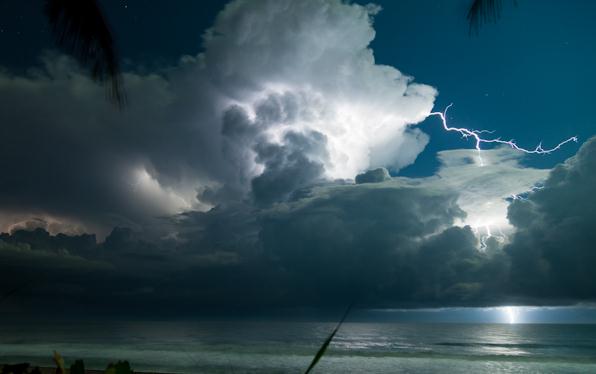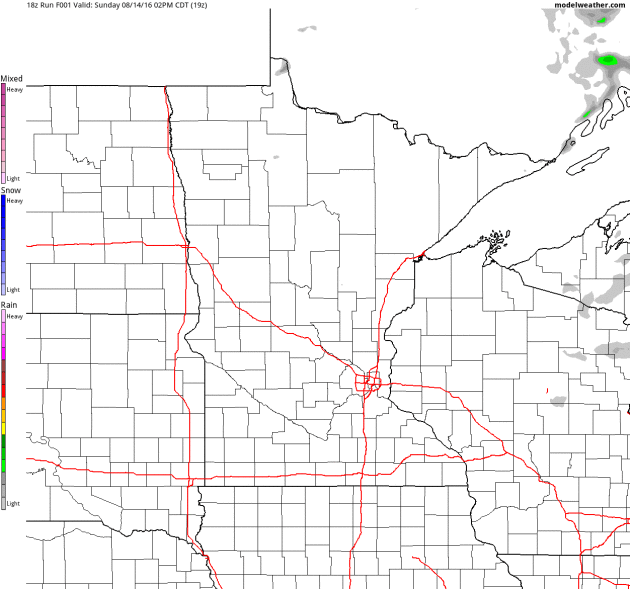81 F. average high on August 14.
94 F. high on August 14, 2015.
August 15, 1936: St. Paul swelters with a high of 108.

Beware of Bewildering Bolts from the Blue
For 40 years I've been preaching the perils of lightning, and on Saturday I nearly got a taste of my own medicine. I was on our deck, grilling, skies clearing in the distance, a light rain falling.
Then a blinding flash of light and deafening crack of thunder - followed by a few choice words.
It was a "bolt from the blue", a reminder to wait 30 minutes after the last thunderclap before heading back outside. Lightning can travel 10 miles - horizontally.
Every year Americans are struck and killed by lightning, blue sky above; a distant thunderhead giving off a deadly spark. Be careful out there.
Warm sunshine today gives way to a few T-storms tonight and Tuesday. Daytime highs approach 90F Thursday and Friday before a late-week line of T-storms arrives, marking the leading edge of a hefty cool front - a preview of what's to come. Weekend highs hold in the 60s across most of Minnesota; lows dipping into the 40s and 50s.
Almost time to dig a sweatshirt out of cold storage.
In spite of a weak La Nina (cool) signal in the Pacific I expect a warmer than normal signal to linger well into October this year.
A Few Swarms of Storms.
T-storms may be heavy late tonight into Tuesday (but probably not
severe). There's a better chance of strong to severe T-storms late week,
especially Friday, as a vigorous cool front approaches.

Summer into Friday, Touch of Autumn This Weekend?
ECMWF model guidance hints at temperatures having a tough time cracking
70F in the MSP metro area next weekend, and highs should, in fact, hold
in the 60s over much of the state with a stiff breeze. No, this doesn't
necessarily mean an early fall is imminent. Graphic: WeatherBell.
90F By Late Week?
NOAA models are in fairly good agreement, showing highs in the upper
80s to near 90F by Thursday, possibly Friday, before the inevitable
weekend temperature dip. Source: Aeris Enterprise.
Dig Out The Light Jackets.
By Sunday morning temperatures are forecast to dip into the mid and
upper 40s up on Leech Lake. This weekend will be our first (real) hint
of late September.
Photo credit: "In this aerial photo over Robert, La., stranded people wait on flooded U.S. Route 190 after heavy rains inundating the region Saturday, Aug. 13, 2016. Louisiana Gov. John Bel Edwards says more than 1,000 people in south Louisiana have been rescued from homes, vehicles and even clinging to trees as a slow-moving storm hammers the state with flooding." (AP Photo/Max Becherer) (Max Becherer).
Thousands Displaced in Flood-Drenched Louisiana. More perspective via The New York Times: "After
days of ruinously heavy storms in southern Louisiana, rain-swollen
rivers and creeks continued wreaking damage across the state, inundating
neighborhoods and submerging roads and highways. More than 7,000 people
have had to be rescued from the flooding this weekend, Louisiana
officials said, in a waterlogged stretch from the parishes to the north
and east of Baton Rouge west past the city of Lafayette. Thousands of
homes have been flooded, forcing more than 5,000 people to spend
Saturday night in shelters. Those stranded by the waters found
themselves further marooned by a massive cellular network failure..."
Photo credit: "On Saturday, residents evacuated from Providence Boulevard in Hammond, La., where floodwaters inundated homes." Credit Max Becherer/Associated Press.

Animation credit: "Aerial view before and after in Denham Springs, Louisiana." (After image: Patrick Dennis/The Advocate via AP, Before Image: Google Earth).
Photo credit: "Residents wade through floodwaters from heavy rains in the Chateau Wein Apartments in Baton Rouge, La., Friday, Aug. 12, 2016." (Gerald Herbert/AP)
The Times Picayune in New Orleans has live-blogging on the ongoing flooding disaster across Louisiana and Mississippi at NOLA.com.
How To Help Louisiana Flooding Victims. CNN has details.

How Bad Is Your Air Conditioner For The Planet? Here are a few nuggets excerpted from a New York Times article: "...Air-conditioning presents other problems: As of 2009, nearly 90 percent of American homes have air-conditioners, which account for about 6 percent of all the country’s residential energy use. All that air-conditioning releases about 100 million tons of carbon dioxide each year. According to historians and others,
the widespread availability of air-conditioning has allowed for more
development in the hotter parts of the country — the South and the
Southwest — where air-conditioning use is the highest in the country..."
Surveyed Scientists Debunk Chemtrails Conspiracy Theory. Here's the intro to a story at UCI News: "The world’s leading atmospheric scientists overwhelmingly deny the existence of a secret, elite-driven plot to release harmful chemicals into the air from high-flying aircraft, according to the first peer-reviewed journal paper to address the “chemtrails” conspiracy theory. Researchers from the University of California, Irvine, the Carnegie Institution for Science and the nonprofit Near Zero organization asked 77 atmospheric chemists and geochemists if they had come across evidence of such a large-scale spraying program, and 76 responded that they had not. The survey results were published Wednesday in Environmental Research Letters. Heat from aircraft engines produces condensation trails that can be clearly seen from the ground. A small but vocal segment of the population firmly believes that these are composed not merely of condensed water vapor but of chemicals and elements such as strontium, barium and aluminum that powerful, high-level entities have been intentionally and covertly releasing into the atmosphere for decades..."
Photo credit: "A commercial airliner produces a condensation trail in the skies over California." Mick West
Image credit: Flickr CC BY 2.0/Blude.
Image credit: "Hubble looks out at Pisces B, a dwarf galaxy 30 million light-years away. Less than a hundred million years ago, it doubled its star formation rate—a sign that it fueled up by passing through dense gas." Photograph by NASA/ESA/Hubble.
TODAY: Warm sunshine. Winds: SE 5-10. High: 83
MONDAY NIGHT: Clouds increase, T-shower late. Low: 66
TUESDAY: Sticky again, few T-storms likely. Winds: S 8-13. High: 83
WEDNESDAY: Sunnier, drier and hotter. Winds: NW 5-10. Wake-up: 67. High: 87
THURSDAY: Muggy, feels like prime-time summer. Winds: SE 10-15. Wake-up: 70. High: near 90
FRIDAY: Steamy sun, heavy T-storms arrive late. Winds: SE 10-15. Wake-up: 73. High: 88
SATURDAY: Partly sunny, cooler breeze. Winds: NW 10-15. Wake-up: 62. High: 72
SUNDAY: Feels like September. Peeks of sun. Winds: NW 8-13. Wake-up: 54. High: 69
Climate Stories...
Photo credit: "Diablo Canyon Nuclear Power Plant in San Luis Obispo County, California is at risk of premature closing for political reasons. On Thursday, a letter to Governor Jerry Brown of California, about how nuclear energy was essential to fighting global warming, was sent by Dr. James Hansen and the world’s leading climate scientists. The plant is safe, can withstand a large earthquake, tsunami and any other disaster, provides billions to the local economy, and produces more clean energy than all the wind turbines in California combined." Photo: John Lindsey.

A Court Ruling That Could Save the Planet. Bloomberg View has the story: "A federal court this week upheld the approach that the government uses to calculate the social cost of carbon when it issues regulations -- and not just the cost imposed on Americans, but on people worldwide. It’s technical stuff, but also one of the most important climate change rulings ever. The social cost of carbon is meant to capture the economic damage of a ton of carbon emissions. The assumptions that go into the analysis, and the resulting number, matter a lot, because they play a key role in the cost-benefit analysis for countless regulations -- not only the Obama Administration’s Clean Power Plan, but also fuel economy rules for automobiles and trucks and energy efficiency rules for appliances, including refrigerators, microwave ovens, clothes washers, small motors, and clothes driers..." (Image credit: NASA).
Guest Post: Piecing Together the Arctic's Sea Ice History Back to 1850. Here's an excerpt of an interesting post at Carbon Brief: "...Most fundamentally of all, the new dataset allows us to answer the three questions we posed at the beginning of this article. First, there is no point in the past 150 years where sea ice extent is as small as it has been in recent years. Second, the rate of sea ice retreat in recent years is also unprecedented in the historical record. And, third, the natural fluctuations in sea ice over multiple decades are generally smaller than the year-to-year variability..."
Image credit: "Sea ice cover maps for the annual minimum in September, for the periods 1850-1900, 1901-1950, 1951-2000, and 2001-2013. The maps show the sea ice extent in the lowest minimum during each period, which are in years: 1879, 1943, 1995, and 2012."
Growing Corn Like It's 2065 To Study Climate Change Effects. The Star Tribune reports: "At
the University of Minnesota, researchers are growing corn in
greenhouses like it’s the year 2065. The effort is part of a long-term
plan to study how corn will grow under weather conditions considerably
different from today’s, predicted in climate change models for a
half-century out. “Many models show that with increasing temperatures we
could be seeing a reduction in corn yields, so that’s something we
would like to investigate under controlled conditions,” said Tim
Griffis, University of Minnesota professor of biometeorology and one of
several researchers directing projects..."
No comments:
Post a Comment